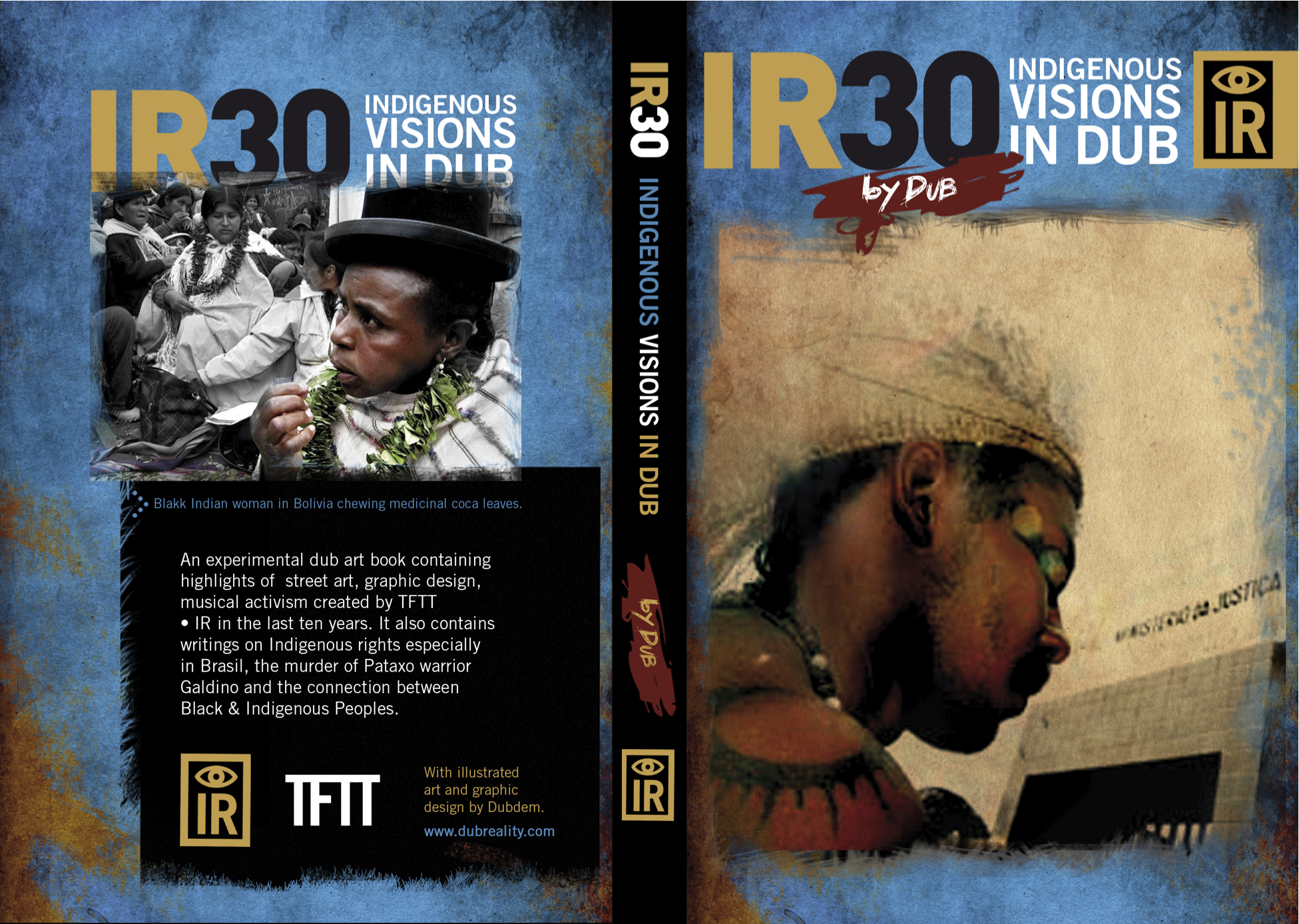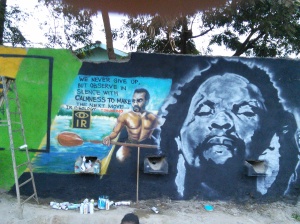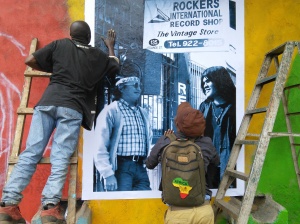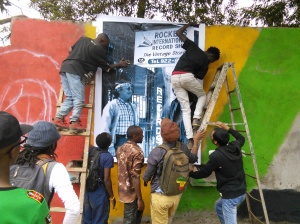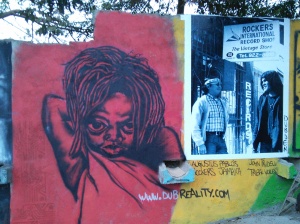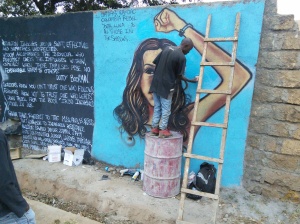IR arrived in Nairobi, Kenya, knowing no one. And like all our travels, like-minded people were attracted to us in the most roundabout ways. After arriving, we read a newspaper headline stating, due to security concerns, the USA & Australia wanted to pull all of their volunteers and NGO workers out of the country. Yet propelled by the kindness, warmth, and respect shown to IR and buoyed by the creativity of the people we met, IR spontaneously decided to create a mural project. In a few days, everything just flowed as we assembled a crew of Graffiti artists, technical assistants and filmmakers. The fact that IR managed to organize all of this without a phone amazed the locals. (It’s just what we do, no bigger.) They were also astounded that we arrived not knowing anyone, yet our intuition and the forces of dub guided us directly to the exact people we needed to succeed.
The Kenyan grafitti artists we worked created the mural based on a design by Brazilian IR conspirator Dubdem.
. Dubdem based his design on the recently published IR book “IR30 Indigenous Visions In Dub” and incorporated references to struggles in different parts of the world. Elements were pulled from the Palestinian liberation movement and the Idle No More aboriginal protests in North America to efforts to remember the murdered Brazilian indigenous warrior Galdino, dub references to Jamaican Ras Tafari and to dub master Augustus Pablo along with images from the campaign to Free Leonard Peltier
There was a memorable moment when IR first met the Graffiti artists and we noticed one of them was copying music from his laptop for one of his friends. Curious, we glanced at his musical selection and were amazed to see he had playlists with Asian Dub Foundation, Deeder Zaman and the solo album of Dr Das. All these musicians are IR collaborators. Not only was it a proof subversive music transcends artificial borders and obstacles created by politics, but for us it was also a sign we were working with the right people!
We were able to get access to a wall in the Korogocho slum where we could paint the mural. To understand present day Nairobi, is important to know the historical context that gave rise to these slums. Nairobi is a vibrant, thriving metropolis with some beautiful locations. However, when British colonialists built the modern infrastructure of Nairobi, they kept what they considered the best and most beautiful locations for themselves. Adjacent to the neighbourhoods where they had their big houses, they created limited substandard housing estates for their servants to live in—so they could have their servants arrive early to work and leave late. This housing was extremely limited in a strictly constrained area. When new residents, those with less resources, arrived to the city they were unable to build in what was considered the “good” part of town, so they they built in these areas which, understandably, became overcrowded, polluted, with poor sanitation and living conditions. These areas became the slums of Nairobi and into which were also dumped the garbage & industrial waste from the “good” neighborhoods. As elsewhere in the world, being a resident of a slum carries with it a stigma that can negatively affect a person’s possibilities in employment, keeping them down and out and out-of-sight; ghettoizing them.
The neighbourhood of Korogocho, labeled a slum, is viewed with great apprehension and fear due to the negative news reports coming from the Kenyan media hyping the violence. This, in turn, generates the socialization of the general society to steer clear of the place. Someone commented to us that they thought a great majority of the middle class of Nairobi had never stepped foot in Korogocho. They grabbed at a number, saying perhaps less than 20% ever took a step inside Korogocho. A news media that sensationalizes the violence and portrays the residents as lazy people who don’t want to work reinforces the stereotypes. Our experiences in Korogocho revealed that, despite the immense fear the community generates in the minds of many in the country, there was a lot more to the community than most people realize. To us, this emphasizes the importance of approaching and learning with an open mind and using one’s own critical thinking instead of relying on media reports, no matter how unbiased they claim to be.
The day of painting the mural was incredible and amazing. During the process of the painting, residents were asking great questions about some of the themes and names on the mural, which was the intent. To start a conversation about the themes. After seeing the quality of the work of the artists there were many requests to paint other parts of the community. Some were curious how we doing it and we explained this was a totally independent project not connected with any political party, NGO or government agency. This was just something we decided to do and with cooperation made it happen. One wise resident said to us “that’s the African way, when we used to want to get something done we used to come together and make it happen!”
African self reliance dub!
The Kenyan Graffiti artists Kerosh, Bhupi, Swift, Chege and Uhuru are a group of very talented and conscious artists. They really gave their all in the painting of the mural working with great concentration. There were some crazy scenes, especially the last night when darkness fell, true darkness as there was no lighting in the street at all. But there was a bit left to do, up high and, due to late hour and the closing time of where we could store equipment, we had already stowed away the ladders. In order to paint the last 5 percent of the wall, a crew of us had to hoist one of the artists on our shoulders while he painted in absolute pitch black, no-stars-in-the-sky darkness! This section was the cover of Dutty Bookman’s “Tried &True” on the wall. We couldn’t even see the print out of the book cover we had been working from, it was that dark. Luckily, we had memorized the text related to Dutty’s work, so we read it out aloud while the artist brushed it on the wall in his impeccable hand. It really was an unbelievable moment and a testament to the great skill and determination of these artists! IR was very touched by the words of appreciation for the mural by the residents of Korogocho. One of the great pleasures of making the IR mural in Korochogo was the participation of a resident Joshua who worked tirelessly of his own volition; helping us with many of the difficult logistics of preparing the wall for painting, the movement of equipment and tools, the mounting of banners and painting. Joshua worked tirelessly into the dark of the night.
When we talked further with Joshua and visited his house, which was adorned with Bob Marley posters, Joshua took us to see a side of Korogocho that we realized few in Nairobi had ever seen. Joshua is passionate about the environment and the replanting of trees and to this end, has created a nursery behind his house, with the seedlings of trees and he has worked planting hundreds & hundreds of trees in the area. He has worked with others to create a garden with different crops, a nursery with seedlings of trees and and he has dug into the earth to create a place where water from the adjacent polluted river can be filtered & used to water the gardens. He told me that this specific area, so healthy and green now, was once the site of scores of extra judicial killings/executions of youth in the area by amoral police. In the midst of the dust, corrugated iron, industrial waste-related pollution, and bitter, harsh memories, Joshua and others have created their own thriving oasis.
We invite anyone who is in Kenya to visit the mural. Here are the directions: when in Nairobi city center board bus from Ronald Ngala street bus number 14 that goes to Koribangi, the final stop. Korogocho is approximately 200 metres from the bus stop where Koribangi bus has its final stop. (Says so much that the bus doesn’t make it all the way to the people who need it the most.) The IR33 mural is at Daniel Comboni Primary School just as you get into the ghetto of the Korochogo neighborhood.
Upon reflection we realize the success of creating this mural is due to the combined collective forces of the energy, sheer determination and hard work of the residents of Korogocho who helped us, IR conspirators and the awesome Graffiti artists who gave their all to this project. Without these combination of energies and effort there is no way we would have pulled off painting a massive mural in just one day! IR is honored to have met some very special spiritually strong people who remained kind, open and generous despite a social context that often pulls them in the opposite direction and to these folks we give a special Rebel salute. (You know who you are.)
With all the attention electoral politics in Kenya was receiving, IR deliberately painted on the mural the following quote from former chairperson of the American Indian Movement, John Trudell, that is also found in the book “IR 30 Indigenous Visions In Dub.”
‘Leaders know you can’t trust one who follows. Followers know not to trust one who leads.”
IR had been discussing with the Graffiti artists how the F.B.I so feared the power of the oratory of John Trudell that they kept a 20,000 page file on him. We passed on some links to where they could listen to the words of John Trudell. As we were editing the video one of the Graffiti artists walked in. He was shaking his head and grinning. He said, “I was listening to the John Trudell. Wow, he is so so deep! Now I get why they were so afraid of him!”
you can view the video here
you can download the DUBuMENTRY video we made here
The DUBuMENTARY Download
http://www.dubreality.com/KorogochoDUBuMENTARY&GrafittiExperience.mp4.zip
NAIROBI GRAFFITI ARTIST SITE AND FACEBOOK PAGE
http://streetartnairobi.com/ https://www.facebook.com/streetartnairobi
IR BOOKS ON LULU INCLUDING IR30 Indigenous Visions In Dub
http://www.lulu.com/spotlight/dubreality
IR has to also send out a special Rebel salute to the producers and musicians Dr Das, Ramjac and Sawandi. There is a tremendous amount of painstaking work and attention to detail put into these mixes, which most people are unaware of and so, we need to point it out. Dub folks really strive to make the highest quality work possible with their own resources. IR conspirators work for free. Often mixes are done over and over till we are satisfied with the final results! These three musicians extend us their time while juggling economic survival issues, being a good parent (our special dub salute to Sawandi who is a great father! Hi Sade!) as well as a myriad of other responsibilities. When these artists put so much effort into making tracks for IR it inspires us to reciprocate that same effort. So we can clearly state that the efforts of these 3; Dr Das, Ramjac & Sawandi were directly responsible for the genesis of this video!
This is an abridged version of an account of the making the mural found o the IR33 webpage
http://www.dubreality.com/IR33Kenya.html
